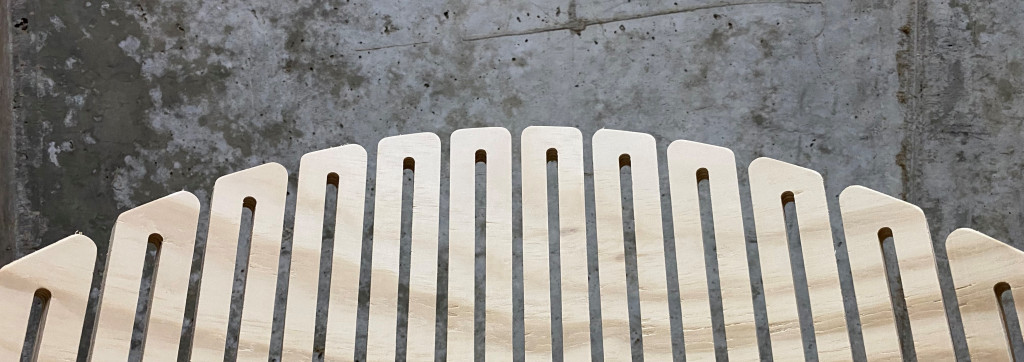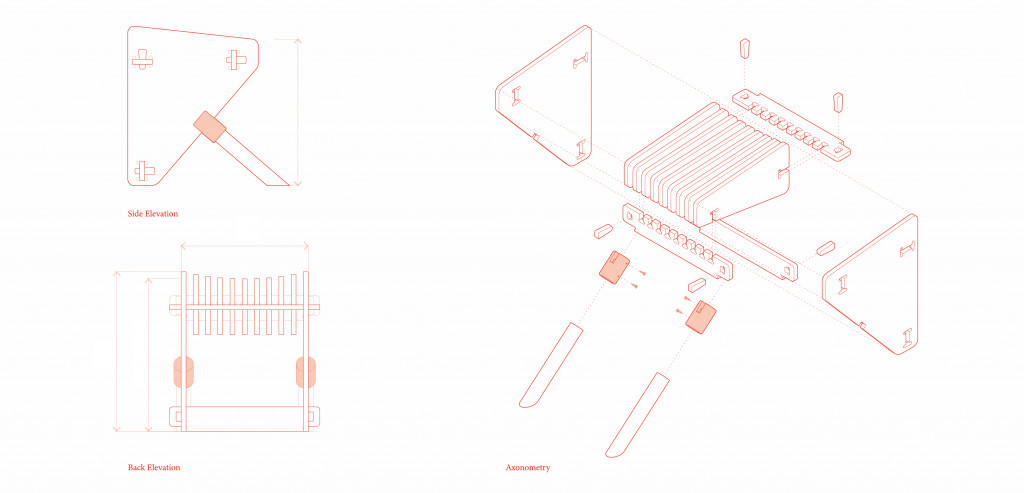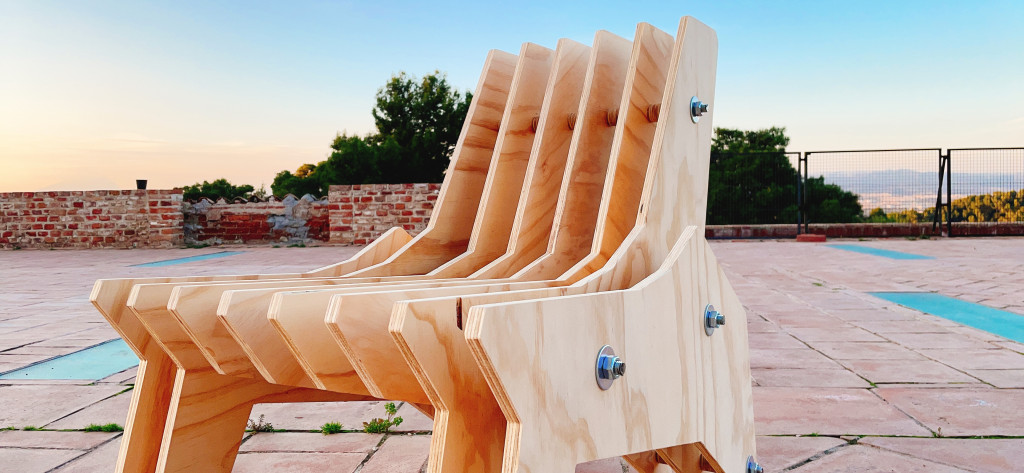
IAAC’s Master in Ecological Buildings & Biocities (MAEBB) challenges students to develop sustainable solutions to everyday living, including furniture concepts and fabrication. Located in the beautiful Collserola Natural Park in Barcelona, Valldaura Labs is home to MAEBB’s students, where the “learning-by-living” approach gives students the freedom to conceptualise, design and produce their prototypes. This is all done using timber sourced locally at Valldaura.
Using wood as the source material, our MAEBB class of 2020/2021 use digital fabrication to bring their concepts to life.
Here are some of the student projects:
PROJECT: X-PODIUM
by Christa Hörburger
If you live in the same place as you study, you are tempted to use digital applications to improve your life in that place. The idea of a new podium was born based on the realisation that the existing one is too high for shorter people and the table top dimensions were marginally small. So I decided to design and produce a new one for the studio in Valldaura. The primary requirement, besides the reduced height and the lager tabletop, was easy assembly and disassembly to allow for use in different rooms and conditions.
PROTOTYPE
The prototype was produced on a scale of 1:3 with the laser cutter. I used this prototype to test the performance of the 3D printed fasteners and the appearance of the engraving. The conclusion of the prototype was to give the furniture more strength and to relieve the structural stress on the fasteners by closing the circle of forces. To achieve maximum stability I decided to tie the two wooden wings together with a rope.
You can see the full documentation here:
http://www.iaacblog.com/programs/x-podium/
Project Credits:
Institute for Advanced Architecture of Catalonia – Master in Ecological Buildings & Biocities 2020/21
Project Name: X-Podium
Faculty: Eduardo Chamorro
Students: Christa Hörburger
PROJECT: Plyable | Pliable plywood chair
by Philipp Wienkämper
plyable started with the question “how to make a comfortable and interactive plywood chair?”. Inspired by the possibilities of digital fabrication tools, I decided to use a technique to change the material properties from rigid to pliable. Therefore, I would use a technique called “living hinge” not only to archive the flexibility of the material but also as a focus for the Design. In addition, it was also important to keep the assembly simple with the least parts possible while still maintaining stability and respecting the dimensions of a lounge chair.
The prototype was produced to test the flexibility and strength performance of the backrest-hinge and the connections of the separate parts. Therefore, I cut the prototype out of a 5mm plywood board with a laser cutter. The scale of this prototype is 1:3, which was important so the living hinge would have similar properties to the 1:1 model, which made from a 15mm plywood board
Full documentation here:
http://www.iaacblog.com/programs/plyable_philipp_wienkaemper_maebb/
Project Credits:
Institute for Advanced Architecture of Catalonia – Master in Ecological Buildings & Biocities 2020/21
Project Name: plyable
Faculty: Eduardo Chamorro
Students: Philipp Wienkämper
PROJECT: Tamboret y Taula – Spatially Efficient Furniture For Domestic Work Spaces
by Marilia Sofía Fernández

‘Tamboret y Taula’ is a furniture set through which subtractive and additive manufacturing techniques are explored. Ever since the COVID-19 pandemic, the need for domestic work/study spaces is increasing: therefore, spatial efficiency is a priority for this design. Taula can double as a desk (to be used with Tamboret) or as an individual floor lounge chair. When Taula is used as a desk, Tamboret is stored under it.
Taula is a desk that can also turn into a floor lounge chair only by rotating it 90 degrees. The dog-bone joint commonly used in subtractive digital fabrication is thoroughly explored and expressed in all its possible scenarios.
You can see the full documentation here:
http://www.iaacblog.com/programs/spatially-efficient-furniture-domestic-work-spaces/
Project Credits:
Institute for Advanced Architecture of Catalonia – Master in Ecological Buildings & Biocities 2020/21
Project Name: Tamboret y Taula
Faculty: Eduardo Chamorro
Students: Marilia Sofía Fernández
PROJECT: O P T I M O S
by Yangchuan Tian

Optimos is a ready-to-assemble chair composed of CNC’d Baltic birch plywood, steel rod, wood spacers, and joint connectors. Among users of all ages and sizes, this project aims to create a robust standing chair that engages an enjoyable experience that allows users to sit in different positions. Inspired by the rocking horse that we used to ride when we were young, this chair is inspired by the configuration of rhinoceros or horses that have muscular shoulders and limbs. Vertically arranging plywood pieces makes the chair even strong to work under a wide range of loads from compression. With the consideration of ergonomics, the chair was designed with an embracing curvature for the hip from outer pieces to the middle ones.
The chair’s appearance changes from angle to angle and has subtle difference hidden throughout all the straight lines. The extended back edge allows users to put their arm onto it to stretch or to put books temporarily. Lastly, the chair is called Optimos to recall the sense of instinctive strength.
You can see the full documentation here:
http://www.iaacblog.com/programs/digital-fabrication-10/
Project Credits:
Institute for Advanced Architecture of Catalonia – Master in Ecological Buildings & Biocities 2020/21
Project Name: OPTIMOS
Faculty: Eduardo Chamorro
Students: Yangchuan Tian
PROJECT: MISILLA – A CHAIR WITH 3D PRINTED JOINTS
by Dafni Vakalopoulou
Misilla is a small chair made of plywood and PLA 3D printed joints. The 3D printed joints are designed in order to fit exactly to the 15mm plywood and they could be used to solve similar problems in other applications.
Misilla’s frame is composed by two main pieces that shape the legs and the back and they are connected by four identical crosspieces that are fixed with a simple wood joinery system. Two identical pieces are designed to form the back and the sitting area of the chair and they are connected to the frame with the key elements of misilla’s concept, which are the 3D printed joints.
You can see the full documentation here:
http://www.iaacblog.com/programs/misilla-3d-printed-joints-dafni-vakalopoulou/
Project Credits:
Institute for Advanced Architecture of Catalonia – Master in Ecological Buildings & Biocities 2020/21
Project Name: MISILLA
Faculty: Eduardo Chamorro
Students: Dafni Vakalopoulou
Are you interested in learning sustainable architecture and design? Applications are now open for the upcoming class of 2021/2022, held at Valldaura Labs. Find out more about IAAC’s Master in Ecological Buildings & Biocities (MAEBB)
Next application deadline is May 31st!
